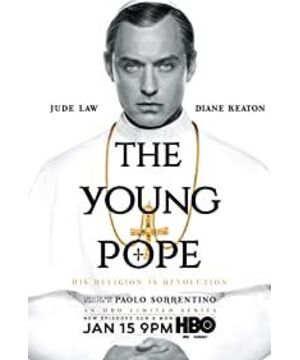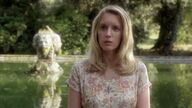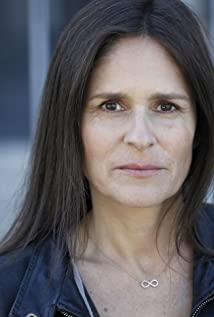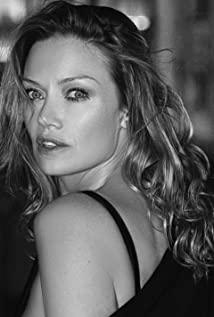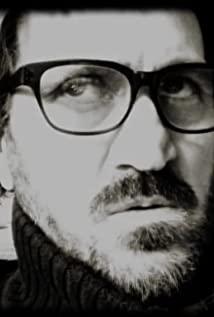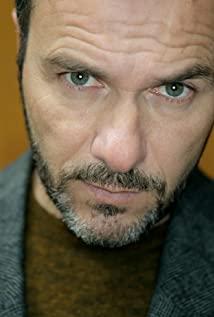Presumably the original intention of the producers to choose Jude Law was to mislead people into projecting the actor's own chaotic life onto the character, and more bluntly, to make people imagine the private life of such a handsome Pope. The Pope in the play is really different from the real Pope, regardless of age, appearance, and shape, they are like night and day. In the play, the Pope appeared under the cover of thousands of naked children, and made surprising remarks in front of everyone's eyes, which made the Holy See stunned inside and out. Well, although the true face of such a young pope is still surprising, Jude Law uses the sparkle in his eyes and the cadence of his voice to describe the conceit, hesitation, cheerfulness, cunning and contradiction of the pope. All kinds of details are displayed. As he stretched his arms and prayed to God, his face twisted and he murmured a pleading, such a few scenes that made the miracle happen with a penetrating persuasive power. Diane Keaton has become active again in recent years, and her role in the series is quite heavy. With her years of film experience, she is absolutely familiar with portraying an older woman who has believed in Christ for many years. In her TV debut, Diane Keaton's role as a nun, mother and friend, served as an inspiration and support for the young Pope, allowing him to develop his strengths as head of the Holy See. However, everything is not smooth sailing. When the nun thought that the Pope was going farther and farther on the road of desolation, she also acted in secret, colluding with the cardinals to subvert the world.
Director Paulo Sorrentino often pushes the series forward with unexpected handwriting. When people finally believe that the Pope is an absurd figure, the next scene is completely different from your imagination; Redemption, when the Vatican seems like a stormy sea, the next second of bad luck will be invisible. Just as the director claimed, the Pope was as unpredictable as himself, acting strange and strange: the Pope was addicted to smoking and Cherry Coke; claimed to not believe in God, and then made a joke; refused to show his true face; The name is despised by Pope Pius XII; he blatantly provokes the cardinal and refuses to compromise; when people gradually discover that his childhood experiences have influenced his conservatism, and that he has an extraordinary devotion in his heart, he disregards it. Saying that I always wanted to be a child. This is a Pope who cannot be rationalized, so the director is outstanding in all forms of expression, but the old wine is still in a new bottle, but the wine is mellow and delicious, just like the opening music although it is Bob Dylan's The classic track "All Along the Watchtower", but with a burst version of the sonorous hip-hop singer Delvin as the soundtrack, really creates a surprising audio-visual effect; as shown in the ten classic art in the opening, the church has experienced everything After the stimulation of growth, transition, war, division, degeneration, etc., it should be a return to conservative after overcorrection. This is probably the real reason why the real Pope and the Holy See did not attack the virtual Pope. In truth and absurdity, "The Young Pope" does not focus too much on the shameless scandal and corruption of the Holy See, but emphasizes conservatism in a convincing plot, and takes a serious attitude in Jude Lawland. The strength of faith is output in the eyes of the color.
A large number of classic works of art appear in the series as the background to set off the characters. The most impressive is the first meeting between the Pope and Esther in the third episode. The Pope suddenly fainted in her arms. The gestures of the two are clearly replicas of Michelangelo's famous sculpture Pietà. Period classics frequently appear in other contexts, such as the very eccentric magdalena ventura with her husband and son, in which Madeleine is a bearded woman breastfeeding baby. The most concentrated artwork is the title. The title of the episode contains ten classic works of art. There is a meteor running through it to express the history of the Holy See. This is the reflection of history and art, and it is the key to help understand the whole story. Please refer to the following for details. :
1. The Adoration of the Shepherds
by Gerard van Honthorst
This painting depicts the birth of Jesus in Bethlehem, where the local shepherds received Angelic revelation rushed to the birthplace of Jesus to celebrate Christmas. Gerard van Honthhorst belonged to the Baroque painter and was deeply influenced by Carragvagio.
2. "Delivery of the Keys"
by Pietro Perugino
depicts that in the Gospel of Matthew St. Peter received the keys of the kingdom, which represent forgiveness and the way to heaven. Perugino was Leonardo da Vinci's friend and Raphael's teacher. The Sistine Chapel houses several of his works, one of which hangs on the north wall of the chapel and is one of many in a series depicting the story of Jesus.
3. "Converted to the Road to Damascus"
Author: Caravaggio
"Acts" Chapter 9 describes that Saul, who was once a persecutor of Christianity, was hunting Christians on the way to Damascus, and suddenly encountered a vision, Hearing the words of Jesus inexplicably in his ears, he was convinced and repented of falling from the horse and converted to become St. Paul. This painting is in the Roman Forum Cathedral (Santa Maria del Popolo church). The use of light and shadow in the whole painting is excellent. Except for Paul, who fell off his horse, which is in the focus of strong light, all other elements are placed in shadow. The description of the horse is very detailed, and the posture of slowly raising its hoofs to avoid the sudden fall of the master is fully revealed.
4. The First Council of Nicea (The First Council of Nicea)
Nicea is located in what is now Iznik, Bursa province. The Roman Emperor Constantine I held a meeting here on July 4, 325 AD to forcibly adopt the Creed of Nicaea as Christian orthodoxy, settle theological disputes and establish the rule of the Roman Church. The Emperor Constantine in the center of the picture is berating: "Division in the church is worse than war."
5. Peter the Hermit riding a white mule with a crucifix in his hand and circulating through the cities and villages preaching the Crusade
by Francisco Hayez
Peter the Hermit A priest in the northern French city of Amiens, he is said to be the real initiator of the first crusade. The author, Francisco Hayez, is a master of the romantic school of painting who is good at presenting the present with history.
6. "St. Francis Receiving Stigmata"
by Gentile da Fabriano
depicts St. Francis praying in Mount Alverno At the same time, he was sanctified by the angel seraph and gave him the five wounds of the stigmata of Jesus, so St. Francis became the second Jesus. The seraphim angel in the painting is clearly in the style of the Middle Ages and the early Renaissance, and the author Fabriano is recognized as one of the ancient masters of the Italian Renaissance. The work bridges Gothic and early 15th century Florence styles.
7. "Thomas of Villanueva DistributingAlms"
by Mateo Cerezo (Mateo Cerezo)
St. Thomas was originally a Spanish friar, ordained archbishop in 1544 and canonized in 1658 only. He was acclaimed for his widespread sympathy for the poor. The author is a Spanish Baroque painter. This painting is in the Louvre Museum in Paris.
8. Michelangelo Presenting the Model for the Completion of St Peter's to Pope Pius IV
by Domenico Passignano )
The name of the painting completely explains the meaning of the picture, and it is worth mentioning that this is the original St. Peter's Basilica. St Peter's Basilica was built for defensive purposes after being sacked by Arab pirates in AD 846, forming the Vatican City. The author Demanic Basciano was an Italian painter of the late Renaissance. He is known for his talent, and is known for his fast painting speed.
9. The St. Bartholomew's Daymassacre by
François Dubois
) led by the Catholics to purge the French Protestants. However, there is evidence that this is actually a political trick of the French King Charles IX. On August 18, 1572, the nobles Marguerite de Valois and Henri de Navarre wed. The wedding was supposed to be a symbol of reconciliation between Catholics and Protestants. However, on the sixth day after the wedding, the king of France suddenly ordered the immediate execution of the leader of the Protestant Huguenot sect. Subsequently, Catholics carried out massacres against Protestants. The tragedy of the Holocaust created an unprecedented rupture in France, raising questions about the crown and pondering the damage that religious divisions have wrought on the kingdom's traditions.
10. The 9th Hour
by Maurizio Cattelan
This work shows Pope John Paul II being knocked to the ground by a meteor. This is clearly a provocation. The ninth hour refers to the ninth hour after the crucifixion that Jesus cried out: Lord, why have you forsaken me? , and then died on the cross. The accepted interpretation of this work is that the author is alluding to the long-term depravity of the Holy See. Shooting stars come from the sky, which can be understood as shooting stars, even if God himself punishes the Holy See. Although the Pope was hit, he still survived and held the cross, showing that the Holy See is corrupt but indestructible. The iron-clad Holy See, the flowing Pope, has now welcomed a young Pope.
Public number: Ding Shendeng
View more about The Young Pope reviews


